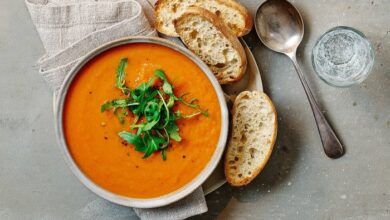
Simple Beef Pot Roast: A Comforting Classic
Simple beef pot roast is a dish that embodies the very essence of comfort food. It’s a hearty, flavorful meal that’s perfect for a cold winter night or a cozy family gathering. The beauty of pot roast lies in its versatility, making it adaptable to various dietary needs and preferences.
From traditional recipes passed down through generations to modern twists on the classic, there’s a pot roast for everyone to enjoy.
The origins of pot roast can be traced back centuries, with variations found in cuisines around the world. Whether you’re enjoying a classic American pot roast with carrots and potatoes, a French pot au feu with its rich broth, or a hearty Irish stew, the core concept remains the same: slow cooking a tough cut of beef until it becomes incredibly tender and flavorful.
Introduction to Simple Beef Pot Roast
There’s something undeniably comforting about a hearty beef pot roast. Its rich, savory aroma fills the kitchen as it simmers slowly, promising a meal that’s both satisfying and soul-warming. Beyond its deliciousness, beef pot roast is a versatile dish that can be adapted to suit various dietary needs and preferences.
It’s a blank canvas for culinary creativity, allowing you to experiment with different flavors and techniques.
The History and Cultural Significance of Beef Pot Roast
Beef pot roast has a rich history, its origins tracing back to ancient times when people relied on slow cooking methods to tenderize tough cuts of meat. The dish has evolved over centuries, taking on different forms and flavors in various cultures around the world.
In many cultures, pot roast has been a staple dish for generations, passed down through families and cherished for its simplicity and affordability.
“Pot roast is a dish that evokes a sense of tradition and nostalgia, reminding us of home-cooked meals and family gatherings.”
Simple beef pot roast is a classic comfort food, perfect for a chilly evening. It’s all about slow cooking and letting the flavors meld together. If you’re looking for something a bit more intense, check out this recipe for insane oven beef ribs , which will have you licking your fingers.
But for a hearty, homey meal, there’s nothing quite like a pot roast, simmered to perfection.
In French cuisine, for instance, a similar dish called “pot-au-feu” is a classic, featuring a combination of beef, vegetables, and herbs simmered in broth. In the United States, beef pot roast is often associated with comfort food and is commonly served with mashed potatoes, gravy, and vegetables.
Choosing the Right Cut of Beef
The key to a melt-in-your-mouth pot roast lies in selecting the right cut of beef. While any cut can be cooked in a slow cooker, some are better suited for this method than others. Understanding the characteristics of different cuts will help you choose the one that best suits your taste and preference.
Cuts of Beef for Pot Roast, Simple beef pot roast
Choosing the right cut of beef for pot roast is crucial for achieving a tender and flavorful result. Cuts with a higher fat content, like chuck roast, brisket, and round roast, are ideal for slow cooking. These cuts are tougher than other cuts, but they become incredibly tender when cooked slowly.
- Chuck Roast:This cut comes from the shoulder of the cow and is known for its rich flavor and good marbling. Chuck roast is often used for pot roasts, stews, and braises.
- Brisket:This cut comes from the lower chest of the cow and is another excellent choice for pot roast. Brisket is known for its intense flavor and high fat content, which renders down during cooking, resulting in a moist and tender pot roast.
- Round Roast:This cut comes from the hind leg of the cow and is leaner than chuck roast or brisket. While round roast is less flavorful than other cuts, it becomes tender when cooked slowly. It is a good option if you prefer a leaner pot roast.
Marbling in Beef
Marbling refers to the streaks of fat within the muscle of the beef. It plays a crucial role in the flavor and tenderness of pot roast. Marbling adds moisture and richness to the meat as it renders during cooking.
Cuts with higher marbling are ideal for pot roast because they become more flavorful and tender during slow cooking.
A good rule of thumb is to choose a cut of beef with a marbling score of “Select” or “Choice” for the best results.
Preparing the Beef: Simple Beef Pot Roast
Once you’ve chosen the perfect cut of beef for your pot roast, it’s time to get it ready for cooking. This involves a few simple steps that will ensure a flavorful and tender final product.
Trimming Excess Fat
Before you start cooking, it’s essential to trim any excess fat from the beef. This will help to prevent the pot roast from becoming greasy and will also ensure that the meat cooks evenly. To trim the fat, use a sharp knife to cut away any visible layers of fat.
You can leave a thin layer of fat on the beef, as this will help to keep the meat moist during cooking.
Simple beef pot roast is one of my go-to comfort food meals. It’s so easy to throw together and the results are always delicious. I love how the meat gets so tender and flavorful after a long, slow cook.
And while I’m on the topic of slow cooking, have you ever tried roasting a whole chicken in a pan ? It’s another fantastic option for a hearty, satisfying meal. But back to the pot roast, the rich gravy that forms at the bottom of the pot is just heavenly over mashed potatoes or rice.
It’s a dish that’s always a winner!
Seasoning the Beef
Seasoning the beef is an important step in preparing a delicious pot roast. The seasonings you use will determine the flavor profile of your dish. A simple combination of salt and pepper is often all you need, but you can also add other spices like garlic powder, onion powder, paprika, or dried herbs.
Browning the Beef
Browning the beef is an essential step in preparing a flavorful pot roast. Browning creates a rich, caramelized crust on the outside of the meat, which adds depth of flavor to the dish. To brown the beef, heat a large Dutch oven or other heavy-bottomed pot over medium-high heat.
Add a tablespoon or two of oil to the pot and allow it to heat up. Then, add the beef to the pot and cook for about 5 minutes per side, or until it is nicely browned. Be sure to sear all sides of the beef evenly.
Using a Dutch Oven
A Dutch oven is the ideal cookware for preparing pot roast. Its heavy-bottomed construction helps to distribute heat evenly, ensuring that the meat cooks evenly and thoroughly. The tight-fitting lid of a Dutch oven also helps to trap moisture, which keeps the meat moist and tender.
The Art of Slow Cooking
Slow cooking is a culinary technique that involves cooking food at low temperatures for extended periods, typically several hours or even overnight. This gentle approach to cooking is particularly well-suited for tough cuts of meat, transforming them into tender, flavorful dishes that melt in your mouth.
Understanding the Principles of Slow Cooking
The magic of slow cooking lies in the interplay of time and low heat. When you cook meat slowly, the collagen and connective tissues break down, releasing moisture and transforming the tough fibers into tender, succulent strands. This process also allows the flavors to meld and deepen, creating a rich and complex taste that simply can’t be achieved with quick cooking methods.
Simple beef pot roast is a classic comfort food that’s perfect for a chilly evening. It’s so easy to make, and the aroma of slow-cooked beef and vegetables is irresistible. Of course, no meal is complete without a sweet treat, and these double chocolate frozen fudge pops are the perfect way to end a hearty meal.
After all, a little bit of chocolate is always a good idea, especially when it’s paired with a delicious pot roast.
Methods of Slow Cooking
There are several popular methods for slow cooking, each with its own advantages and nuances.
- Stovetop Simmering: This classic technique involves gently simmering the meat in a pot of liquid on the stovetop. It’s a simple and versatile method that allows for easy adjustments to the cooking time and temperature.
- Oven Roasting: This method involves cooking the meat in a covered Dutch oven or roasting pan in a low oven. The gentle heat of the oven allows the meat to cook evenly and develop rich, caramelized flavors.
- Slow Cooker: The slow cooker is a modern marvel designed specifically for slow cooking. It’s a hands-off method that requires minimal attention, making it perfect for busy weeknights. The slow cooker’s sealed environment traps moisture, ensuring that the meat stays tender and juicy.
Benefits of Slow Cooking
Slow cooking offers a host of benefits that make it a favorite among home cooks.
- Tenderization: Slow cooking is the ultimate solution for tenderizing tough cuts of meat like chuck roast, brisket, and short ribs. The extended cooking time breaks down the connective tissues, resulting in melt-in-your-mouth tenderness.
- Flavor Enhancement: The slow cooking process allows the flavors of the meat and the accompanying ingredients to meld and deepen, creating a rich and complex taste.
- Convenience: Slow cooking is incredibly convenient, especially for busy schedules. You can simply throw all the ingredients into the slow cooker and let it do its magic while you focus on other tasks.
- Versatility: Slow cooking is incredibly versatile and can be used to prepare a wide range of dishes, from hearty stews and soups to flavorful pulled pork and tender pot roast.
Flavorful Ingredients and Techniques
A pot roast’s rich, comforting flavor comes from the careful selection and combination of ingredients. Beyond the beef itself, a symphony of vegetables, herbs, spices, and liquids creates a harmonious and delicious masterpiece. Let’s explore the key players in this culinary orchestra and discover how to elevate your pot roast to new heights.
Common Flavorful Ingredients
The magic of a pot roast lies in the interplay of flavors. Vegetables, herbs, spices, and liquids all contribute to the final taste. Here’s a look at some common ingredients and their roles in enhancing the dish:
- Vegetables:Vegetables not only add color and texture but also contribute a depth of flavor. Onions, carrots, and celery are classics, providing sweetness and earthiness. Potatoes, parsnips, and turnips add starchy richness. Root vegetables like beets and rutabagas offer unique sweetness and earthy notes.
- Herbs:Fresh or dried herbs add a fragrant dimension to the pot roast. Thyme, rosemary, and bay leaves are popular choices, providing warmth and depth. Parsley, oregano, and sage offer different aromatic profiles, depending on your preference.
- Spices:Spices like garlic powder, onion powder, black pepper, and paprika lend savory notes and complexity. Experiment with other spices like cumin, coriander, or chili powder for a bolder flavor.
- Liquids:The liquid used in a pot roast plays a crucial role in both flavor and tenderness. Beef broth is a classic choice, providing a rich base. Wine, beer, or even tomato juice can add unique flavor profiles.
Techniques for Enhancing Flavor
Beyond the ingredients themselves, certain techniques can elevate the flavor of your pot roast:
- Aromatics:Searing the beef before adding it to the pot roast creates a flavorful crust. This technique intensifies the beef’s natural flavors and adds depth to the dish. The browning process also creates a delicious fond, which is the flavorful residue left in the pan after searing.
- Deglazing the Pan:After searing the beef, deglazing the pan with wine, broth, or even water helps release the fond, adding another layer of flavor to the sauce.
- Creating a Flavorful Sauce:As the pot roast cooks, the ingredients release their flavors into the liquid. To create a rich and flavorful sauce, simmer the liquid until it reduces and thickens. This process intensifies the flavors and creates a delicious sauce to spoon over the meat and vegetables.
Serving and Accompaniments
After the long, slow cooking process, your beef pot roast is ready to be enjoyed! The rich, tender meat, infused with savory flavors, begs for a hearty and comforting meal. Serving a pot roast is a delightful experience, offering a range of possibilities to suit different tastes and preferences.
Serving Suggestions
The beauty of pot roast lies in its versatility. It can be served as a main course for a casual family dinner, a special occasion gathering, or even a cozy weeknight meal. The serving style can vary based on the occasion and your personal preference.
Here are some ideas:
- Classic Style:Serve the pot roast sliced, piled on a bed of mashed potatoes, and adorned with a generous ladle of the flavorful cooking juices. This classic combination is a comforting and satisfying meal.
- Elevated Presentation:For a more sophisticated touch, serve the pot roast in individual portions. Slice the meat thinly and arrange it artfully on a plate. Garnish with roasted vegetables, a drizzle of gravy, and a sprig of fresh herbs.
- Sandwich Delight:Transform leftover pot roast into delicious sandwiches. Slice the meat and serve it on crusty bread with a spread of mustard, mayonnaise, or horseradish cream.
Accompaniments
The rich flavors of pot roast pair beautifully with a variety of accompaniments. Here are some classic choices:
- Mashed Potatoes:Creamy mashed potatoes are a classic pairing for pot roast, providing a comforting and satisfying contrast to the savory meat.
- Roasted Vegetables:Roasted vegetables, such as carrots, potatoes, onions, and parsnips, complement the pot roast perfectly. The roasting process enhances their natural sweetness and adds a delightful depth of flavor.
- Crusty Bread:Crusty bread is essential for soaking up the delicious gravy and juices that accompany the pot roast.
- Green Salad:A fresh green salad adds a refreshing contrast to the hearty flavors of the pot roast.
Repurposing Leftovers
The beauty of pot roast extends beyond the initial meal. Leftovers can be transformed into a variety of delicious dishes. Here are some ideas:
- Pot Roast Soup:Shred the leftover pot roast and add it to a hearty soup. The meat will add flavor and texture, creating a satisfying and comforting meal.
- Pot Roast Tacos:Shred the leftover pot roast and use it as a filling for tacos. Add your favorite toppings, such as cheese, salsa, and sour cream, for a delicious and easy meal.
- Pot Roast Hash:Dice the leftover pot roast and combine it with potatoes, onions, and peppers for a flavorful and satisfying hash.
Variations and Experimentation

The beauty of a simple beef pot roast lies in its adaptability. You can customize it to your liking, creating a unique dish that reflects your personal taste and culinary preferences. This section explores different ways to play with flavors, cooking techniques, and ingredients, encouraging you to experiment and discover your own perfect pot roast.
Flavor Profiles
There are countless ways to add depth and complexity to your pot roast. Experimenting with different flavor profiles can transform this classic dish into a culinary adventure.
- Classic Beefy:This profile relies on the natural flavor of the beef, enhanced by simple ingredients like onions, carrots, and celery, often with a touch of Worcestershire sauce for umami depth.
- Mediterranean:Infuse the pot roast with Mediterranean flavors by adding herbs like oregano, thyme, rosemary, and bay leaves, along with garlic, lemon juice, and olives.
- Asian Inspired:For an Asian twist, incorporate soy sauce, ginger, garlic, sesame oil, and star anise.
- Spicy Southwestern:Add a kick with chili powder, cumin, paprika, and chipotle peppers in adobo sauce.






